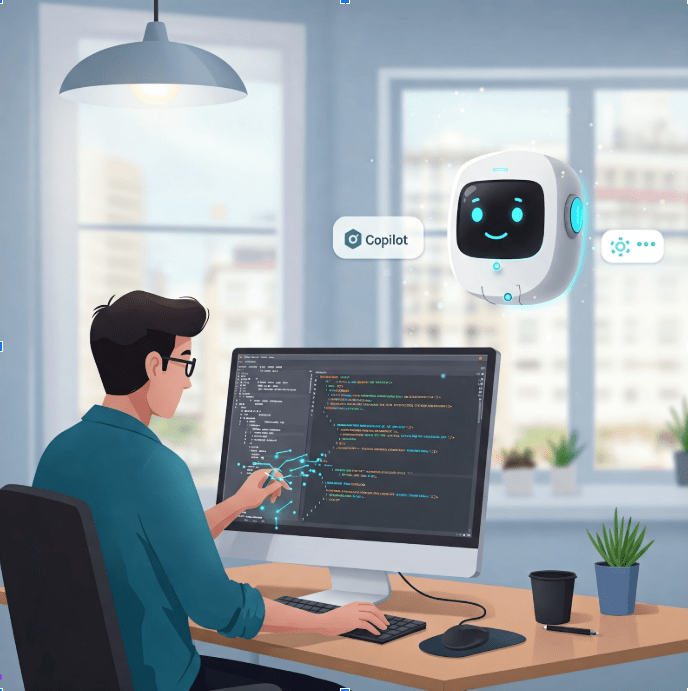
TIBCO BusinessEvents (BE) has always enabled enterprises with the possibilities of interacting with realtime events.
Now, with the advancement of Artificial Intelligence (AI), BE continues to push the boundaries of possibilities.
One such groundbreaking innovation is the BE Copilot, a tool designed to assist business users and enhance productivity for power users and developers.
This article will dive deeper into BE Copilot, its core capabilities, exploring its use cases, and the value it drives.
What is a BE Copilot?
BE Copilot is an advanced AI-powered tool specifically engineered to integrate seamlessly into the development lifecycle of any BusinessEvents Projects. It leverages natural language processors, large language models (LLM) and prompt engineering to understand context, generate code, and offer intelligent suggestions, effectively acting as a virtual pair programmer.
Core Capabilities
BE Copilot’s effectiveness stems from its powerful underlying capabilities:
- Contextual Understanding: It can understand the context of the code being written, including various components of BE projects like the Concepts, Rules, Rule Functions, Events and project structure, to provide highly relevant suggestions.
- Natural Language Processing (NLP): Developers can interact with BE Copilot using natural language commands, making it intuitive and easy to use.
- AI Models: The AI is trained on vast datasets of code, enabling it to learn coding patterns, common algorithms, and best practices across the entire BE Project Structure.
- Integration with VS Code IDE: BE Copilot seamlessly integrates with popular Integrated Development Environments (IDEs) i.e. VS Code Extension, ensuring a smooth workflow and faster adoption for developers. For existing BE users, this IDE will provide an unified user-experience combining the capabilities for both business users and power-users. This is why the new VS Code IDE is also called One-Studio.
- Adaptability and Learning: The tool continuously learns from user interactions and feedback, improving its suggestions and capabilities over time.

Following is a visualization of BE Copilot in action using VS Code extension and AI prompt.
Key Use Cases of BE Copilot
BE Copilot offers a wide array of applications that streamline the development process:
- Code Generation: It can generate rules, rule-functions, and even an entire project based on natural language descriptions or existing code patterns. This significantly reduces the time spent on repetitive coding tasks.
- Code Completion and Suggestions: As developers write code, BE Copilot provides intelligent auto-completion suggestions, variable name recommendations, and even identifies potential bugs or inefficiencies in real-time.
- Explanation, Refactoring and Optimization: The AI can analyze existing codebases and explain what it does or suggest improvements for better performance, readability, and adherence to best practices.
- Documentation & Navigation: BE Copilot can automatically generate comments, docstrings, and even comprehensive documentation for functions and classes, ensuring well-documented code. It can also help the user navigate through the product features, understand best practices on configuration, administration and deployment strategies supported by BusinessEvents in design-time and runtime.
- Debugging Assistance: By analyzing error messages and code context, BE Copilot can offer potential solutions or pinpoint the likely source of bugs, accelerating the debugging process.
Value Driven by BE Copilot
The integration of BE Copilot into development workflows brings substantial value:
- Increased Productivity: By automating repetitive tasks and providing intelligent assistance, developers can complete tasks faster and focus on more complex problem-solving.
- Improved Code Quality: With suggestions for best practices, code automation and explanation, BE Copilot helps ensure the creation of cleaner, more robust, and maintainable code.
- Reduced Development Costs: Faster development cycles and fewer bugs translate to lower overall project costs.
- Knowledge Transfer and Onboarding: New team members can quickly get up to speed by leveraging the Copilot’s suggestions and understanding existing codebases more efficiently.
- Enhanced Developer Experience: By taking over tedious tasks, BE Copilot allows developers to concentrate on the creative and challenging aspects of their work, leading to greater job satisfaction.
- Consistency Across Projects: The tool helps enforce coding standards and patterns, ensuring consistency across different projects and team members.
In conclusion, BE Copilot represents a significant leap forward in BusinessEvents development. By augmenting human capabilities with intelligent AI agents, it not only boosts productivity and code quality but also transforms the experience of building solutions using TIBCO BusinessEvents. BE Copilot will be available in the next major release of TIBCO BusinessEvents.
As AI continues to evolve, we can expect even more sophisticated tools that will further reshape the unexplored possibilities of real time event-driven architecture using TIBCO BusinessEvents.
Author:
Suhas Dhekane
Suhas Dhekane is a Senior Principal Solutions Architect at TIBCO. He has worked in Professional Services and Go-To-Market roles at TIBCO for more than eighteen years, leading digital transformation initiatives and helping customers to solve complex Data & AI problems leading to faster adoption and successful business outcomes.
